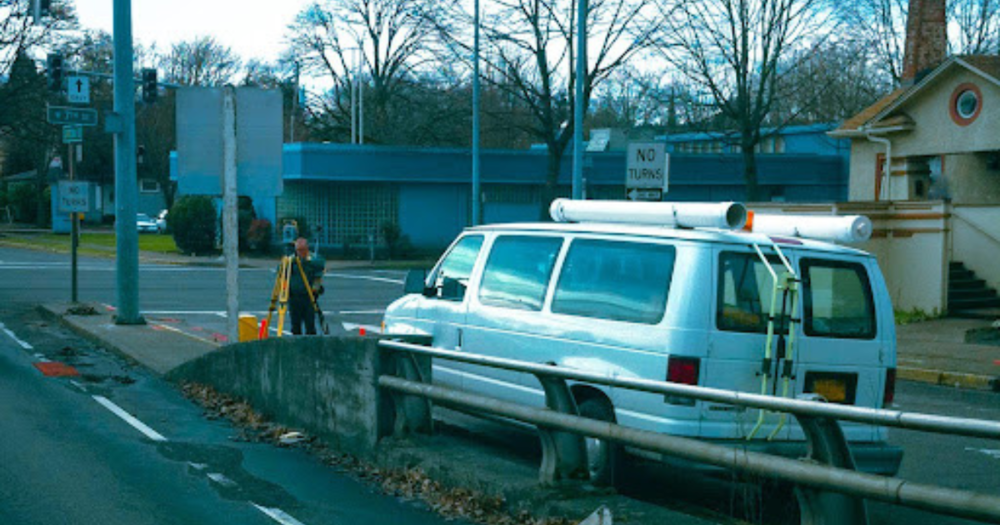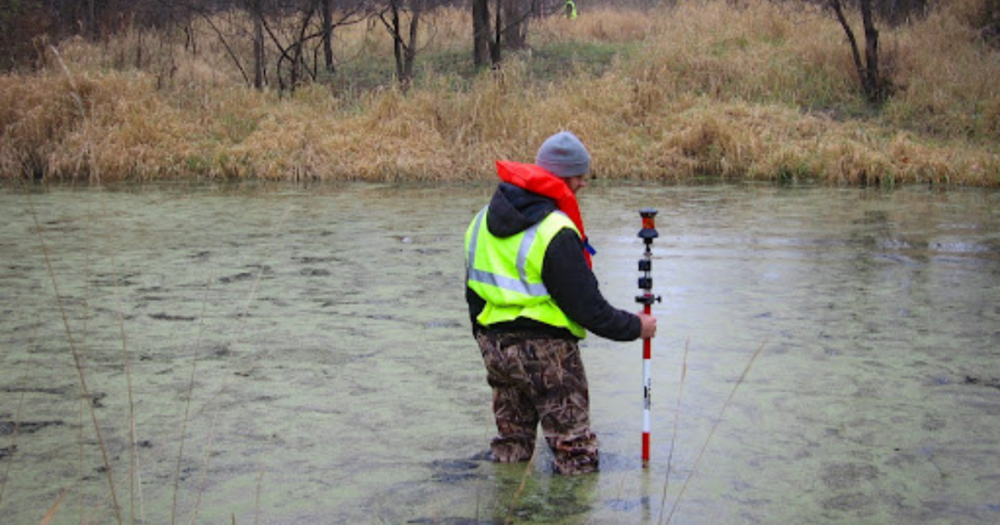
If you’re in the market for a total station, it can be tough to know where to start. With so many models and features, the real challenge isn’t just picking a good one. It’s picking the right one for how you work.
So let’s break down what to look for based on your workflow, accuracy needs, terrain, and more.
Factors to Consider When Choosing a Total Station
Type of Total Station
Traditional total stations are best for small crews or straightforward projects. You’ll need one person to operate the instrument and another to move the prism. These are reliable and cost-effective for basic layout or boundary work.
Robotic total stations can be operated solo. The instrument automatically follows the prism, making them ideal for larger projects, tight labor schedules, or solo work. They speed up workflows and reduce the chance of error.
Check out
Understanding the Different Types of Total Stations for Land Surveying for more information.
Accuracy and Distance Range
Not all total stations measure the same way or to the same degree.
- Angular accuracy is measured in seconds (like 2” or 5”). A lower number means higher precision.
- Distance accuracy is listed like “±2mm + 2ppm,” which means the error is based on a fixed value plus a part per million of the distance measured.
So, when do you need the highest accuracy?
- Sub-arc-second precision is critical for high-stakes jobs like bridge layout, structural monitoring, or tight urban surveying.
- Mid-range specs work great for construction layout, roadwork, or topographic surveys where minor variations won’t affect the outcome.
Match the surveying total station specs to your site’s size and the level of precision your work demands. Overkill on accuracy usually means overkill on cost.
Environmental Durability and IP Rating
- Look for a total station with a solid IP rating (like IP65 or higher) for water and dust resistance.
- Also, check the operating temperature range. If you’re working in snow, heat, or heavy rain, your gear needs to handle the conditions.
- Choose a model with rugged housing and sealed components for mining, highway work, or long days in unpredictable weather.
Compatibility with Data Collectors and Software
If you’re already locked into a digital ecosystem, this step alone can make or break the value of your investment.
- Make sure it plays well with the data collectors and software you already use or plan to use.
- Look for compatibility with systems like Carlson, FieldGenius, or Trimble Access, depending on your workflow.
- Check file formats, export options, and sync methods (USB, Bluetooth, etc.) to avoid bottlenecks when moving from the field to the office.
Battery Life and Portability
- Look for models that run 8–10+ hours on a full charge.
- You’ll want something lightweight if you’re in remote or rugged terrain, but don’t sacrifice runtime unless you have backup power ready.
- Some models let you hot-swap batteries or use external packs, which can be a lifesaver on long jobs.
- If you move between sites a lot, a total station that’s compact and easy to carry matters just as much as how long it runs.
Price and ROI Considerations

The price tag is only part of the story when shopping for a survey total station. A cheaper unit might save money upfront, but if it slows you down or needs replacing in a few years, it will cost more in the long run.
Here’s what to consider beyond the price.
1. Training and Ease of Use
A more intuitive system means less time spent learning and more time collecting data.
If your crew is already familiar with a particular brand or software, sticking with compatible equipment will speed up training and reduce errors in the field.
2. Productivity Gains
Robotic total stations and models with longer range or faster data collection often let you finish jobs quicker. That will mean:
- Fewer hours on-site,
- Lower labor costs, and
- More projects completed each month.
Over time, those gains will outweigh the higher initial cost.
3. Service Life and Build Quality
Look at build materials, IP ratings, and overall durability.
A tough, weather-resistant unit that lasts 8–10 years is a better investment than something that needs repairs or replacement after just a few years.
4. Upgrade Potential
Can the unit work with new data collectors, accessories, or software down the line?
Some survey total station models offer firmware updates or modular designs that keep them relevant as your needs evolve.
5. Support, Warranty, and Brand Reputation
A solid warranty and responsive tech support will save time and frustration when something goes wrong. Before buying, ask:
- How long is the warranty?
- Is service available locally?
- What do other surveyors say about the brand’s reliability?
Buying from a reputable manufacturer with a track record of support helps protect your investment and keeps your projects moving.
If you need more help considering the type of total station for your team, read
Comparing Total Station Models: Entry-Level vs. Professional Surveying Tools.
Traditional vs. Robotic Total Station: Which Is Right for You?
Choosing between a traditional and robotic total station depends on how you work, how many people are on your crew, and how much time (and money) you want to save.
Robotic Total Stations: Built for Speed and Solo Work
A robotic total station will feel like a game-changer if you're a one-person crew or are often stretched thin. Here’s why:
- One operator does it all. The instrument tracks the prism automatically, so you don’t need a second person.
- It sets up and measures faster – no walking back and forth between the instrument and the target.
- It allows for more efficient workflows. With wireless controls and built-in automation, you will collect more data in less time.
Traditional Total Stations: Reliable and Affordable
Traditional total stations are tried-and-true. They may lack automation, but they make up for it with simplicity and lower upfront cost.
Traditional models are a great fit when:
- You have a two-person crew or don’t mind leapfrogging the instrument and prism.
- Your projects are smaller or slower-paced.
- You’re watching your budget but need a dependable total station survey setup.
For a deeper look at both models, read
Traditional or Robotic Total Station? A Guide to Picking the Right Tool.

Total Station Model Spotlight: Stonex
At Baseline Equipment Company, we’ve curated a
lineup of Stonex total stations, each one matched to different surveying needs, crew sizes, and budgets.
Stonex R20 – Compact and Budget-Friendly
- Type: Manual
- Best For: Entry-level users, smaller crews, and simpler sites
- Accuracy & Range: Solid baseline specs for topographic work and basic layout
- Portability: Lightweight and easy to transport
- Value: A strong choice when affordability matters, but reliability can’t be compromised
The
Stonex R20 is ideal for topographic surveys, boundary marking, and basic construction tasks. It’s a smart starting point for teams that want a dependable tool without overbuying.
Stonex R25LR – Versatile Performance with Long-Range EDM
- Type: Manual
- Best For: Construction and civil projects across medium to large sites
- Accuracy & Range: Enhanced reflectorless range and angular precision
- Durability: Rugged enough for challenging site conditions
- Software Compatibility: Pairs well with common data collectors and field software
If your projects vary in size or terrain, the
Stonex R25LR offers the flexibility to handle most of them confidently without requiring a high-end price point.
Stonex R60 – High-Performance with Onboard Android OS
- Type: Manual with integrated software interface
- Best For: Large-scale layout jobs, advanced workflows, tech-forward crews
- Accuracy & Range: 1" angular accuracy; reflectorless range up to 1000m
- Onboard System: Built-in Android OS with touchscreen and full-featured software
- Durability: Built for tough environments with IP66 protection
The
Stonex R60 combines high accuracy with modern convenience. It's ideal for those who want more control in the field and fewer steps between collecting and processing data.
Stonex R180 – Robotic Precision for Solo Surveyors
- Type: Robotic
- Best For: Solo operators, fast-paced construction, and high-volume survey work
- Accuracy & Range: 1" angular accuracy; powerful tracking and long-range EDM
- Automation: Motorized tracking, remote control, and reflectorless measurement
- Efficiency: Maximize output with minimal crew
The
Stonex R180 is designed for professionals who need accuracy, speed, and flexibility – especially when working solo or under tight timelines.
Let’s Make Your Next Total Station the Right One
From basic manual models to advanced robotic systems, there’s a total station built to match your needs – and your budget.
Ready to upgrade your gear?
Explore models and accessories at Baseline Equipment or reach out with your questions.
Need help choosing the right total station? Compare traditional vs. robotic models and what factors—like accuracy, software, and terrain—matter most for your surveying projects.